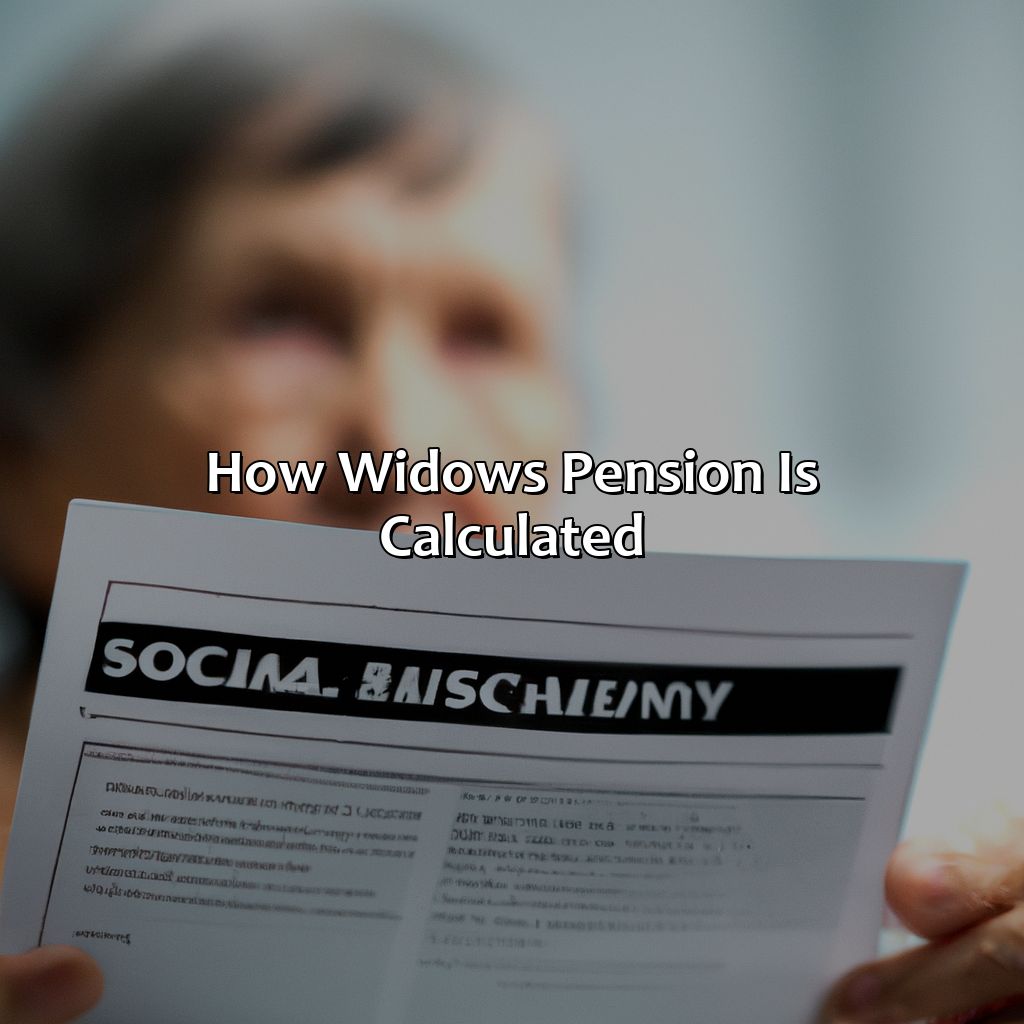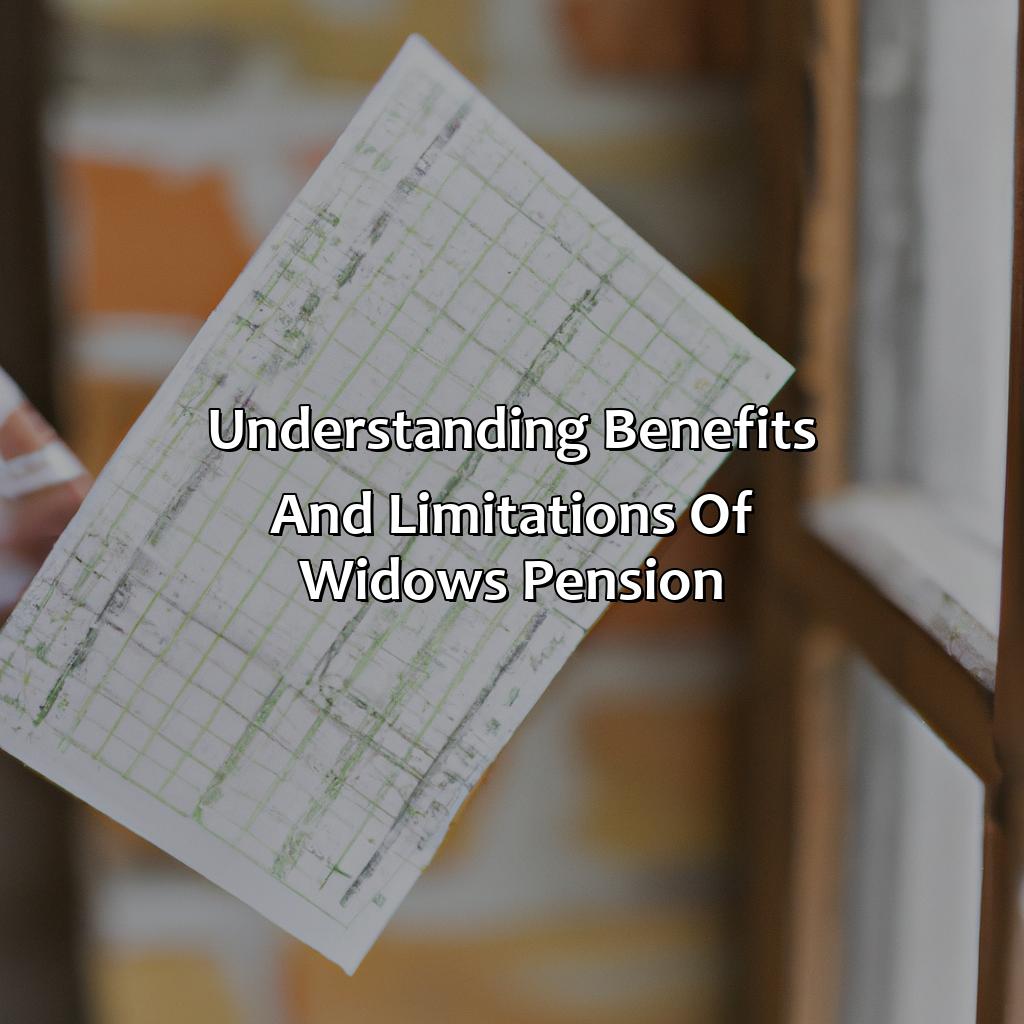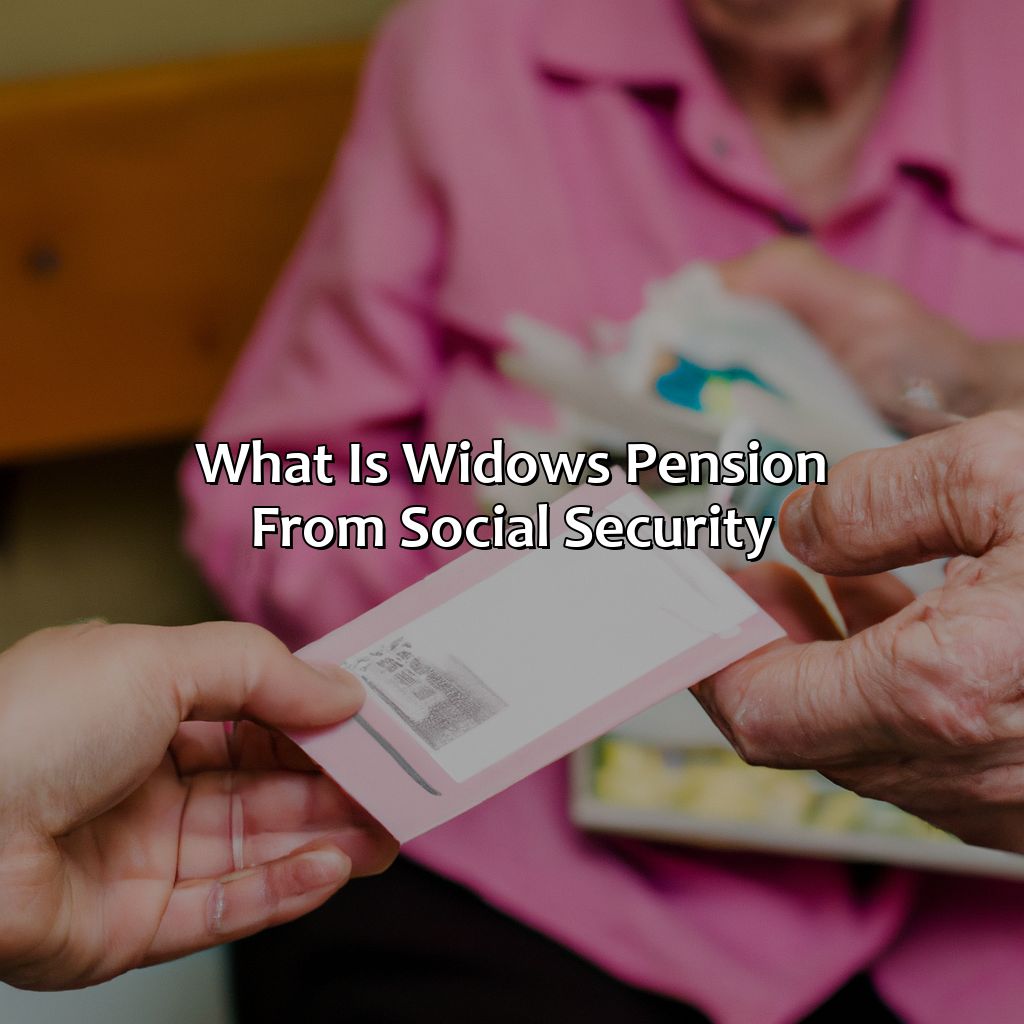What Is Widows Pension From Social Security?
Key Takeaway:
- Widows’ pension from Social Security provides financial support to eligible widows or widowers of a deceased spouse who had worked and contributed to Social Security. It is a monthly benefit that can help cover living expenses and medical costs.
- To be eligible for widows’ pension, the applicant must meet certain requirements such as age, relationship, and duration of marriage. Divorce and remarriage may also affect eligibility.
- The amount of widows’ pension is calculated based on the deceased spouse’s earnings, and the widow’s age at the time of application. It is important to apply for widows’ pension as soon as possible to maximize the benefits.
Are you a widow struggling to make ends meet? Find out if you are eligible for a widow’s pension from Social Security and gain financial relief. You may be able to receive benefits from the government to help support you and your family.
Eligibility for widows’ pension
Widows’ pension from Social Security can be obtained–but only if you meet certain requirements. Age, relationship, and length of marriage must be fulfilled. Furthermore, divorce and remarriage must be taken into account.

Image credits: retiregenz.com by Yuval Arnold
Age requirement
One of the eligibility criteria for receiving a widows’ pension from Social Security is age. The age requirement varies based on individual circumstances, such as whether the widow is disabled or caring for a child. Generally, widows must be at least 60 years old and have been married to their spouse for at least nine months before their death. However, widows who are disabled can receive benefits as early as age 50, while those caring for a child can receive benefits as early as age 50 as well. It’s important to note that remarriage before the age of 60 may affect eligibility.
Pro Tip: To determine your eligibility and potential benefit amounts for a widows’ pension, it may be helpful to consult with a Social Security representative or financial advisor.
If your marriage didn’t survive, at least your eligibility for widows’ pension might.
Relationship requirement
When it comes to eligibility for widows’ pension from social security, there are various requirements that need to be met. One of these is the requirement related to the relationship between the widow and her deceased spouse. The Social Security Administration requires that the widow was married to her deceased spouse for at least nine months before his death. Additionally, the marriage should have been a legal one recognized by state law.
It’s also worth noting that in some situations, divorced spouses may qualify for widows’ benefits if they were married to their ex-spouse for at least ten years, did not remarry before turning 60 years old, and are currently unmarried or remarried after turning 60.
It’s important to keep in mind that every situation is unique and there may be additional qualifications required based on each individual’s circumstances. Therefore, it’s advisable to consult with an expert in this area to gain a clearer understanding of what might be required in order to qualify for widows’ pension.
A true story that highlights the importance of understanding eligibility for widows’ pension involves a woman who lost her husband unexpectedly at a young age. She had assumed she would not be eligible for any type of pension due to her young age and lack of awareness about Social Security benefits. However, after seeking professional advice, she learned that she was indeed eligible for widows’ benefits and this provided her with much-needed financial support during a difficult time.
“Marriage may be until death do us part, but for widows seeking social security, it’s ‘oh, you were only married for three years? Tough luck.'”
Duration of marriage requirement
The prerequisite length of marriage before eligibility for widows’ pension from Social Security is crucial. Requirements vary depending on age, and whether the deceased spouse was receiving benefits or not. The duration of marriage needs to exceed nine months continuously to qualify.
Furthermore, if remarriage occurs before age 60 or before 50 but qualifies due to disability, widows’ pension can be prohibited.
Pro Tip: To ensure you meet the criteria for widows’ pension, promptly report your loss to Social Security Administration and consult with a representative.
When it comes to divorce and remarriage, the only thing certain is that the government will still want their cut of the cake.
Divorce and remarriage considerations
When it comes to receiving a widows’ pension from Social Security, there are certain divorce and remarriage considerations that one should take into account. If the surviving spouse remarries before the age of 60 (or age 50 if they have a disability), they will no longer be eligible for the widows’ benefits. However, if the remarriage occurs after the age of 60 (or 50 with a disability), it will not affect their eligibility.
It’s also important to note that if a surviving spouse is entitled to their own Social Security benefit as well as a widows’ benefit, they will only receive the higher of the two payments. This means that sometimes, remarrying may result in losing both benefits altogether.
One unique consideration is for individuals who have been married multiple times. Depending on when marriages and divorces occurred and how long each marriage lasted, there may be multiple potential sources of widows’ benefits available. It can be complicated to determine which benefit is best to claim, but consulting with a Social Security representative or financial advisor can help navigate this process.
In one example, Jane was receiving a widows’ benefit from her first husband who had passed away many years ago. She eventually remarried, but her second husband passed away as well. While still married to her second husband, Jane was informed by Social Security that she could switch to his widows’ benefit instead of her first husband’s. Doing so increased her monthly payment significantly and provided her with greater financial stability in retirement.
If only calculating the perfect comeback was as easy as calculating a widow’s pension.
How widows’ pension is calculated
Widows’ pension calculation involves considering various factors like the deceased spouse’s earnings history, such as their Social Security benefit at full retirement age. The benefit received by the widow is a percentage of the spouse’s Social Security benefit. The percentage depends on when the widow claims the benefit, typically ranging from 71 to 100% of the spouse’s benefit.
Moreover, if the deceased spouse had already started their benefit, the widow’s benefit would be based on the spouse’s reduced monthly benefit. Additionally, other factors like the widow’s age, disability status, and work history are considered. These factors can affect the percentage of the spouse’s benefit that the widow receives.
It is interesting to note that prior to 1984, widows could receive both their widow’s benefit and their own Social Security benefit simultaneously. However, the Social Security Amendments of 1983 changed the law and eliminated this dual benefit provision.

Image credits: retiregenz.com by James Jones
How to apply for widows’ pension
To get the widows’ pension from Social Security, you must collect the required docs. These are:
- Proof of death
- Marriage certificate
- Birth certificate
- Tax returns
- SSN
Then, you have to fill out the application and give your correct info. Finally, submit the documents.

Image credits: retiregenz.com by Joel Woodhock
Required documents
For those applying for widows’ pension, some documents are required to be submitted. These papers help the Social Security Administration determine the eligibility of the applicant and calculate the correct amount. Here is what you need to know about submitting the necessary items:
- Marriage certificate
- Death certificate of spouse
- The applicant’s birth certificate
- The spouse’s social security number or a copy of their Social Security card
- Last year’s W-2 forms or self-employment tax return (if applicable)
- If already receiving benefits, please provide your social security number and proof of residency.
It is essential to have all these papers organized and easily accessible when completing the application so that there are no delays in processing it.
Additionally, make sure that all information provided is accurate as incomplete or incorrect details can lead to further scrutiny and prolonged waiting times.
The importance of providing proper identification and supporting documentation cannot be overstated as it will help ensure quick processing.
According to Social Security.gov, over four million widows receive monthly living benefit checks that average more than $1606 per month.
If filling out forms was an Olympic sport, the application process for widows’ pensions would be the marathon.
Application process
To begin the process of applying for widow’s pension from social security, it is essential to understand the eligibility criteria. Once you have determined your eligibility, you can proceed with the application process.
Here’s a 3-step guide to assist you in applying for widows’ pension from social security:
- Collect Relevant Documentation: Gather necessary documents like Social Security numbers of the deceased spouse, birth certificates, marriage license and death certificate.
- Choose the Appropriate Mode: You can either apply online through the Social Security Administration website or schedule an appointment at your local Social Security office.
- Submit The Application: Fill out forms needed for applying and attach supporting documents. Submit either online or in person at the Social Security office.
It may take several weeks before your application is processed and approved by the SSA. In case of any delay, contact your nearest Social Security office.
As a Pro Tip, ensure all copy of required documentation is true and correct before submission to avoid potential delays during consideration.
Getting a widows’ pension may help pay the bills, but unfortunately it won’t bring your late partner back to argue about them with.
Understanding benefits and limitations of widows’ pension
Widows’ pension from Social Security provides financial aid to those who have lost their spouse. It is crucial to understand the benefits and limitations of this pension to make informed decisions for your financial future.
This pension plan offers up to a 100% benefit of the deceased spouse’s Social Security earnings. However, there are limitations such as age requirements and income limits that need to be considered. Additionally, remarriage may impact eligibility for the pension.
The widows’ pension also provides survivor benefits for children under certain conditions. It is advisable to consult with a financial advisor to ascertain the best financial decision for your specific situation before applying for the pension.
Pro Tip: Keep important documents, such as birth and marriage certificates, readily available for easy reference when applying for widows’ pension.

Image credits: retiregenz.com by James Arnold
Five Facts About Widows Pension from Social Security:
- ✅ Widows pension from Social Security provides financial support to the spouse of a deceased worker. (Source: SSA)
- ✅ The amount of widows pension from Social Security is based on the earnings of the deceased spouse. (Source: Investopedia)
- ✅ A widow can collect widows pension from Social Security starting at age 60, or age 50 if disabled. (Source: SSA)
- ✅ If a widow remarries before age 60, she is not eligible for widows pension from Social Security. (Source: Investopedia)
- ✅ Widows can still work and receive widows pension from Social Security, but their earnings may affect the amount they receive. (Source: SSA)
FAQs about What Is Widows Pension From Social Security?
What is widows pension from social security?
Widows pension from social security is a benefit that eligible surviving spouses can receive when their spouse who has worked and earned social security benefits passes away. The benefit is a monthly payment from social security to help the surviving spouse financially.
Who is eligible for widows pension from social security?
To be eligible for widows pension from social security, you must have been married to your spouse for at least 9 months before their death. You must also be 60 years old or older, or 50 years old or older and have a disability. Additionally, you must not have remarried before the age of 60.
What is the amount of widows pension from social security?
The amount of widows pension from social security is based on the deceased spouse’s social security earnings and the age of the surviving spouse. The maximum amount a surviving spouse can receive is equal to the full retirement benefit the deceased spouse would have received. However, if the surviving spouse starts receiving the benefit before their full retirement age, the benefit amount will be reduced.
How do I apply for widows pension from social security?
You can apply for widows pension from social security by visiting your local social security office, calling the social security office, or applying online at the Social Security Administration website. You will need to provide documentation of your marriage, your spouse’s death, and your age and income.
Can I receive widows pension from social security and my own social security benefits?
Yes, you can receive both widows pension from social security and your own social security benefits, but the amount you receive may be reduced if you start receiving the benefits before your full retirement age. Social security will calculate the total benefit amount you are eligible for and pay you that amount.
What happens if I remarry after receiving widows pension from social security?
If you remarry after receiving widows pension from social security, your benefit will usually stop. However, if the marriage ends by death, divorce or annulment, you may be eligible for benefits from your previous spouse’s social security earnings.


